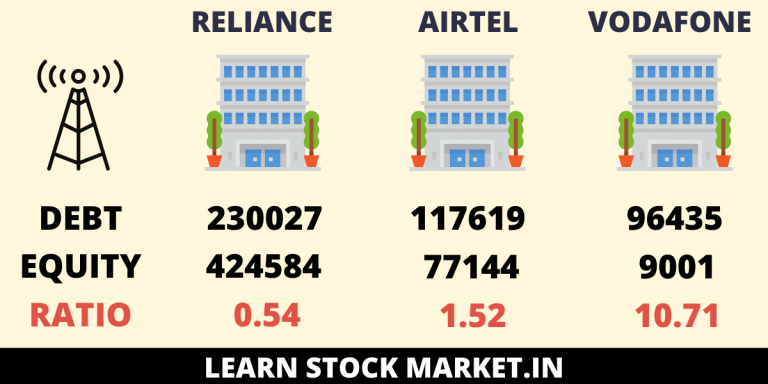Debt to Equity is a very important financial ratio. It measures how much debt a business is carrying, compared to the total capital in the company.
For example, a company has taken debt of 100 crore and has total capital of 50 crore. This means, the debt to equity ratio is 2.
Debt To Equity Ratio Formula

High Debt To Equity Ratio is Risky
Generally, a ‘debt to equity ratio’ of more than 1 is considered to be risky.
A company might be able to sustain high debt during good times. But the situation could change very quickly during recessions.
Sales and profits of a company could go down during economic slowdows, but interest on loans taken has to be paid to lenders (banks).
Currently, the world is fighting a major coronavirus battle. Due to lock-downs across the world, many businesses with high debt are struggling to survive.
This is one of the reasons why a ‘high debt to equity ratio’ could sink even a good business and destroy the wealth of shareholders.
Debt To Equity Ratio Calculation and Example
Let’s take the Telecom sector for our example.
There were more than 10 telecom operators in the last decade. The entry of Reliance Jio disrupted the market.
We are left with just 4 now – Jio, Airtel, Vodafone and BSNL.
Vodafone is fighting for its survival as Jio has emerged as the market leader within 3 years of launch. Airtel is currently the second player and could be the only competitor for Jio, if Vodafone falls.
The Debt column in the Balance Sheet looks troubling for all the telecom companies, including Reliance – but the Mukesh Ambani company has become ‘net debt free’ after attracting some of the world’s top companies to invest in Jio Platforms.
Facebook and Google have invested in Jio. Why haven’t they invested in Airtel or Vodafone – where valuations are lower? The reasons are clear.
The telecom industry has tremendous potential in India and Jio is by far the leading player.
However, do note, Reliance has its other businesses like Oil and Retail – apart from Telecom – and the financials of all its businesses are included in the balance sheet.
The Debt of Reliance at the end of March 2020 was ₹ 2,30,027 crore, while Shareholder’s equity (which includes equity capital and cash reserves) is ₹ 4,24,584 crore.
Divide the debt by total equity and you get 0.54 as the debt to equity ratio.
With more than 40 crore customers on its Jio platform and a fast-growing retail business – things look comfortable for Reliance.

But that isn’t the case for Bharati Airtel. The company has ₹ 1,17,619 crore debt, 77,144 crore as Shareholder’s equity – which gives it a debt to equity ratio of 1.52.
Like it was mentioned in the beginning of the article, when the ratio is above 1, it’s a little risky.
However, Airtel will be raising funds. And, with more than 30 crore customers on its network, along with it remaining one of only two telecom companies in the country – Airtel is likely to benefit and do well in the long run.
For the third telecom player, the situation has gone from bad to worse. The stock price has crashed. The merger between Vodafone and Idea hasn’t helped. The company continues to lose customers every month and the network is getting worse.
The company has nearly 1 lakh crore in debt and around 9000 crore as total equity capital. The debt to equity ratio is a dismal 10.71. Investors should stay far away from this company.


Leave a Comment